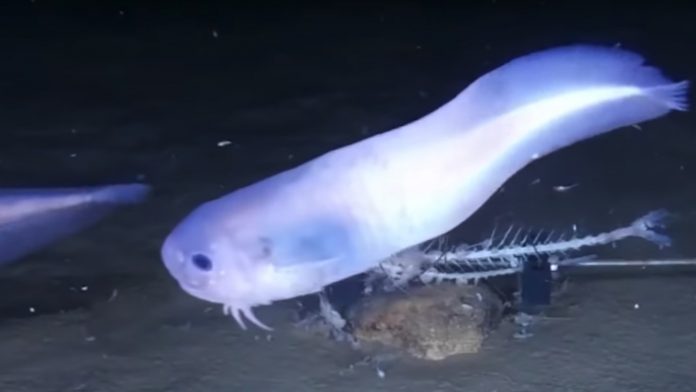Snailfish species discovered in Atacama trench.
Picture a fish. No matter what type you picked, you probably imagined a colorful, scaled creature with fins, gills, and puckered lips (or maybe a toothy open jaw if you went in the shark direction).
A lot of the fish we think of as particularly “fishy” have one thing in common: They come from just a tiny portion of the ocean. By some estimates, humans have explored only a fifth of Earth’s seas, which cover the majority of the planet. The fish that we’re familiar with are just a small sample of the diversity of life underwater.
Three new species of fish, discovered by a massive team of researchers exploring the Atacama trench, highlight that diversity. The blue, pink, and purple Atacama snailfish (a temporary name) were caught by a camera that had been submerged, with bait, to some 26,000 feet (about 8,000 meters). The snailfish’s blobby, translucent bodies look like ghostly tadpoles, and they appear to have very few bones. A report on the fish was presented at this week’s 2018 Challenger Conference, which is focused on marine biology and held at Newcastle University in the UK.
Based on the 400 or so known species of snailfish, the team was able to identify their discovery as part of that family, also known as sea snails or lumpsuckers for their feeding style. A cousin of the Atacama snailfish, the Marianas snailfish, is the deepest-dwelling fish ever discovered, inhabiting depths below 26,600 ft.
Because their habitat is in the deepest trenches of the ocean, Atacama snailfish live without the fear of predation; five miles is an awfully deep dive for a meal. They have also adapted beautifully to their environment. “The hardest structures in their bodies are the bones in their inner ear, which give them balance, and their teeth,” Thomas Linley, a marine biologist at Newcastle, said in a statement. Otherwise, the fish are made of a gooey substance that relies on the crushing pressure of the deep ocean—some 2,500 times what we land-dwellers are used to, according to Smithsonian—to hold their bodies together.
Unfortunately, these evolutionary lifehacks come with a price: When brought to the surface, the snailfish “melted” apart. Researchers were able to preserve one, which is currently being studied further, but the effort of retrieving and storing these fish means they will likely never be as understood as more easily accessible animals, like those that live near the surface of the ocean or on land.















